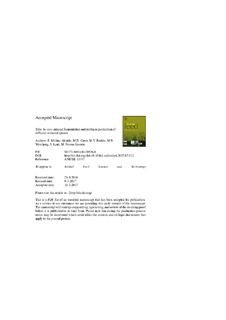| dc.contributor.author | Molina-Alcaide, Eduarda | |
| dc.contributor.author | Carro, Maria Dolores | |
| dc.contributor.author | Roleda, Michael Y. | |
| dc.contributor.author | Weisbjerg, Martin Riis | |
| dc.contributor.author | Lind, Vibeke | |
| dc.contributor.author | Novoa-Garrido, Margarita | |
| dc.date.accessioned | 2017-09-29T08:47:00Z | |
| dc.date.available | 2017-09-29T08:47:00Z | |
| dc.date.created | 2017-04-26T11:53:08Z | |
| dc.date.issued | 2017 | |
| dc.identifier.citation | Molina-Alcaide, E., Carro, M. D., Roleda, M. Y., Weisbjerg, M. R., Lind, V. & Novoa-Garrido, M. (2017). In vitro ruminal fermentation and methane production of different seaweed species. Animal Feed Science and Technology, 228, 1-12. doi: | nb_NO |
| dc.identifier.issn | 0377-8401 | |
| dc.identifier.uri | http://hdl.handle.net/11250/2457427 | |
| dc.description | Author's accepted version (post-print). | nb_NO |
| dc.description | Available from 29/03/2018. | |
| dc.description.abstract | Seaweeds have potentials as alternative feed for ruminants, but there is a limited knowledge on their nutritive value. Seven seaweed species collected along the coast above the Arctic circle of Norway, both in spring and autumn, were assessed for nutrients and total polyphenols (TEP) content, gas production kinetics and in vitro rumen fermentation in batch cultures of ruminal microorganisms. The seaweeds were three red species (Mastocarpus stellatus, Palmaria palmata and Porphyra sp.), three brown species (Alaria esculenta, Laminaria digitata and Pelvetia canaliculata) and one green species (Acrosiphonia sp.). Additionally, the abundance and diversity of total bacteria, protozoa and archaea in the cultures with the three red seaweeds collected in spring were analyzed by quantitative PCR and PCR-DGGE, respectively. The crude protein (CP) content varied widely. Pelvetia had the greatest (P < 0.001) ether extract (EE) content. Non-structural carbohydrates (NSC) content varied from 135 to 541 g/kg DM with brown seaweeds having the greatest values. Ash and CP contents were higher in spring than in autumn (P = 0.020 and 0.003, respectively), whereas concentrations of EE and NSC were not affected by collecting season (P = 0.208–0.341). The TEP values ranged from 1.46 to 50.3 mg/g dry matter (DM), and differed (P < 0.001) among seaweed species and collecting season, being greater in autumn than in spring. The DM effective degradability (DMED), estimated from gas production parameters for a rumen passage rate of 3.0% per h, ranged from 424 to 652 g/kg, the highest values were recorded for Mastocarpus stellatus and Porphyra sp. The lowest DMED values were registered for Pelvetia canaliculata and Acrosiphonia sp. In 24-h incubations (500 mg DM), Palmaria palmata had the highest (P < 0.05) volatile fatty acids (VFA) and methane production (4.34 and 0.761 mmol, respectively) and the lowest (P < 0.05) final pH values and acetate to propionate ratios (6.57 and 2.34, respectively). There were no differences (P > 0.05) among the other seaweeds in VFA production, but Porphyra sp. had the second highest methane production (P < 0.05; 0.491 mmol) compared with the other seaweeds (0.361 mmol; averaged value). The methane/total VFA ratio was not affected (P > 0.05) by either seaweed species or the collection season. Higher final pH (P < 0.05) and lower (P < 0.05) methane and VFA production, ammonia-N concentrations and DMED values were promoted by the fermentation of seaweed collected in autumn compared with those from spring. Among the red seaweeds, there were no species-specific differences (P > 0.05) in the abundance or the diversity of total bacteria, protozoa and archaea. In the PCR-DGGE analysis, samples were separated by the incubation run for all microbial populations analyzed, but not by seaweed species. The results indicate that seaweed species differ markedly in their in vitro rumen degradation, and that samples collected in autumn had lower rumen degradability than those collected in spring. | nb_NO |
| dc.language.iso | eng | nb_NO |
| dc.publisher | Elsevier | nb_NO |
| dc.rights | Attribution-NonCommercial-NoDerivatives 4.0 Internasjonal | * |
| dc.rights.uri | http://creativecommons.org/licenses/by-nc-nd/4.0/deed.no | * |
| dc.title | In vitro ruminal fermentation and methane production of different seaweed species | nb_NO |
| dc.type | Journal article | nb_NO |
| dc.type | Peer reviewed | nb_NO |
| dc.description.version | acceptedVersion | nb_NO |
| dc.subject.nsi | VDP::Matematikk og Naturvitenskap: 400::Zoologiske og botaniske fag: 480 | nb_NO |
| dc.source.pagenumber | 1-12 | nb_NO |
| dc.source.volume | 228 | nb_NO |
| dc.source.journal | Animal Feed Science and Technology | nb_NO |
| dc.identifier.doi | 10.1016/j.anifeedsci.2017.03.012 | |
| dc.identifier.cristin | 1466667 | |
| dc.relation.project | Norges forskningsråd: 233682 | nb_NO |

